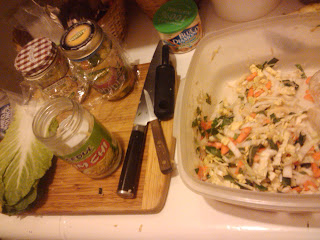Probiotics are live microorganisms that are beneficial to the host organism. In our case, us humans. They thrive in our GI tract, helping to balance out the digestion process and aid in the process of repair. Some people obtain these through supplemental form, by eating yogurt and other fermented or cultured live foods.
I find that the best and tastiest way to get plenty of probiotics in my diet, is by making cultured vegetables... or homemade kimchee or sauerkraut. Although they are time consuming to make, the process is easy and you can make big batches at once, as they keep up to 8 months in the fridge, improving over time. They are inexpensive, too, as they can be made from ingredients that are in season and plentiful, and thus, often on sale.
Their benefits help improve many conditions such as diarrhea, Candida, food allergies, lactose intolerance, IBS and colitis, and help prevent and treat colon cancer, high cholesterol, antibiotic damage and yeast infections. They also work to reduce inflammation, improve immunity and lower blood pressure. Cultured veggies also help you manage your appetite. They are damn tasty!
They can be made from many different kinds of veggies.
I included some of my favorites in my most recent batch.
What I had on hand:
5 collard greens, chopped finely
5 carrots, chopped finely
1 head of Napa cabbage, chopped finely
1 2 inch piece of fresh ginger, grated
1 4 inch diakon radish
1 teaspoon ghost pepper salt
1 teaspoon of cayenne
1 teaspoon of sea salt
a few TB water
3 large cabbage leaves, whole
saran wrap
rubber bands
Mix all ingredients in a large bowl. Pack veggies down into several large glass or stainless steel containers or jars, so the containers have as little air in them as possible.
Fill the jars almost to the top leaving an inch or so. Then roll or fold a cabbage leaf and stuff it into the top, filling the container to the rim. Wrap a piece of plastic wrap over the top, secure with a thick rubber band, and screw on the lid, tight.
In the past, I have found larger containers, with silicone seals and clasp lids to be extremely helpful, but since the seal on my last batch wasn't secure, I thought I'd try it this way for my next batch. Set the containers in a closet or cupboard, one that has a steady room temperature, to culture or ferment for 3-5 days. The warmer the air temp, the faster they will ferment.
"During this fermentation period, the friendly bacteria are having a heyday, reproducing and converting sugars and starches to lactic acid. Once the initial process is over, it is time to slow down the bacterial activity by putting the cultured veggies in the refrigerator. The cold greatly slows the fermentation, but does not stop it completely. Even if the veggies sit in your refrigerator for months, they will not spoil; instead they become more like fine wine, more delicious with time. Properly made, cultured vegetables have at least an eight month shelf life." - Body Ecology Diet
Check on them after day three and see how they are doing. If any scum appears around the cabbage leaves, you may remove the leafs and close the jars again, letting them continue the culturing process in or out of the fridge.
BE CAREFUL! * Sometimes the fermenting activity in the jars will become so BUSY, that the jars will explode when you initially open them, so make sure to only do it over the sink. Taste and enjoy all of the benefits that these delicious vegetables have to offer!
To read more about the benefits of cultured veggies and probiotics, and additional recipes,
click on any of the links below:






